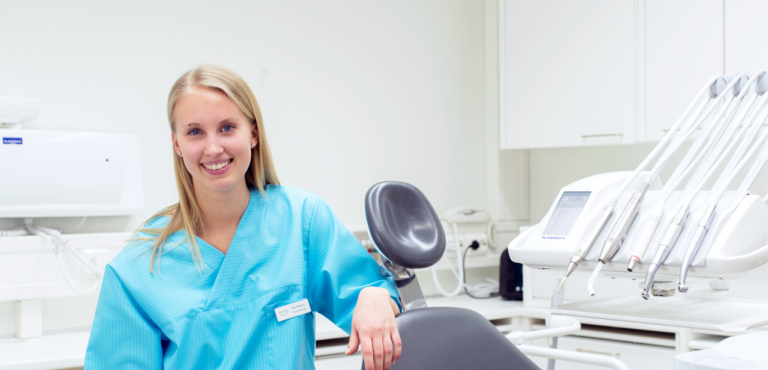Almost all people suffer from gum diseases or problems at some point in their lives. Such problems can include tartar build-up, bleeding gums or gingivitis.
At Tullinsuu dental clinic, gum diseases are treated by a dentist specialised in periodontal disease: a periodontist. Oral hygienists work together with the periodontist to provide the appropriate care for the patient. You can see a periodontist with a referral, but such a referral is not required. A referral can be obtained from your general dentist or oral hygienist.
Gingivitis (inflammation of the gums)
Gingivitis is the mildest form of gum disease. It manifests itself as bleeding and redness in the gum tissue. Treatment usually involves improving oral hygiene and removing gum tissue irritants such as tartar. Regular visits to an oral hygienist help keep the mouth healthy. If desired, patients can be invited to see an oral hygienist at regular intervals to avoid tartar and other gum problems.
Periodontitis (inflammation of the gums and bone)
Untreated gingivitis can slowly destroy the bone tissue around the tooth. This is most often manifested by deepened gum pockets, retracted gums, teeth wobbling, a bad smell or taste in the mouth, and sometimes even pus, but rarely by actual pain.
The primary treatment for the above symptoms is similar to that for gingivitis. A local anaesthesia is given, which allows the dentist to remove the irritants from inside the gum tissue without pain.
In less severe cases, basic treatment is enough to get rid of the inflammation in the bone. Treating periodontitis early on is important as the bacteria around the infected teeth can enter the bloodstream. In the bloodstream, these bacteria increase the risk of heart attacks and strokes by damaging the walls of blood vessels. People with a general medical condition (e.g. diabetes) or those whose defence mechanisms are not functioning normally due to medication (e.g. cortisone) or other causes are at increased risk of heart and brain-related diseases due to untreated periodontitis.
Gum surgery
If basic treatment is not successful in treating gingivitis and the patient has deep gum pockets, gum surgery can be considered. Gum surgery is performed by a dentist specialised in gum diseases.
The surgery is performed under local anaesthesia with the goal of stopping the inflammation as effectively as possible. The gums are lifted and turned aside to allow the dentist to remove the inflamed part of the gum tissue. It is also ensured that the surfaces of the teeth are clean of tartar. The gum tissue is then sewn back into place around the teeth. Thanks to local anaesthesia, the procedure is completely pain-free.
There is rarely any pain after gum surgery as no open wound has been made in the mouth. However, if pain does occur, standard NSAIDs can be used. Sometimes antibiotics can help the surgical site to heal. The need for an antibiotic is determined on the basis of a bacterial culture.
With gum surgery, periodontitis can be prevented from spreading to healthy teeth.
Film and gel treatments
In the case of advanced untreated periodontitis, surgery can be combined with biotechnology for better results. Films that control tissue growth can be used to prevent the soft tissue, which grows faster than bone cells, from filling a lesion. The films are absorbable, meaning they dissolve on their own during the healing process.
During treatment, Emdogain gel can be used to support new bone growth.
The efficacy of this gel is based on nature’s own bone-forming potential, achieved by ‘tricking’ the jawbone. At the application site, the gel causes a reaction in the jawbone similar to that of a new tooth being developed and needing new bone to support it.
When used correctly, both techniques can give good results in repairing the bone damage.
Implant treatment
When installing implants or treating implant site inflammation (implantitis) with gum surgery, film and gel methods can be used. Films are particularly useful when installing implants immediately after tooth extraction. In this case, the film allows the slower-growing bone cells to fill any empty space between the implant and the hole of the extracted tooth.
Should periodontitis develop around the implant, gum surgery can be performed in the same way as for a tooth. In this case, the use of a film or gel is decided on a case-by-case basis.
Home care plays an important role in the health of the gum tissue. Oral hygienists will guide patients in the appropriate home care of an implanted tooth.
